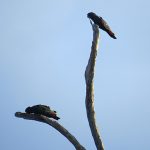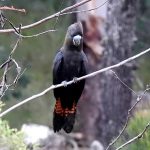GLOSSY BLACK-COCKATOO
The Glossy Black-Cockatoo is a captivating and endangered species of cockatoo native to parts of Australia.
As the name suggests, the Glossy Black-Cockatoo is predominantly glossy black, with a striking yellow or red-orange panel on the underside of its tail feathers. Females typically have yellow tail panels, while males have bright red or orange-red panels. They have a large, powerful bill, well-suited for feeding on their preferred food.
The Glossy Black-Cockatoo is found in specific regions of Australia, including parts of eastern and southern Queensland, eastern New South Wales, and Kangaroo Island in South Australia. They are generally associated with woodlands and forests dominated by certain types of trees that provide their primary food source.
These cockatoos have a specialized diet, mainly feeding on the seeds of various Allocasuarina (sheoak) species. They have a unique foraging behavior where they use their powerful bills to open the cones of sheoak trees and extract the seeds.
Glossy Black-Cockatoos are generally quieter than some other cockatoo species and have a distinctive call that can be described as a high-pitched “kee-ow” or “kee-oww” sound. They often form small family groups or pairs.
Breeding season for Glossy Black-Cockatoos typically occurs between July and December. They nest in tree hollows, usually in large, old eucalyptus trees.
The Glossy Black-Cockatoo is listed as vulnerable to extinction due to habitat loss and fragmentation, as well as threats from land clearing, changes in land use, and the removal of old trees with suitable nesting hollows.
The Glossy Black-Cockatoo holds cultural significance for many indigenous Australian communities, and they have been represented in art and cultural stories for generations.
Conservation efforts are crucial to protect this magnificent species and ensure their survival in the wild. It is important to respect and appreciate these birds from a distance and support initiatives that aim to conserve their natural habitats and promote responsible interactions with wildlife.


